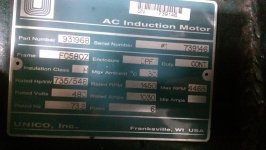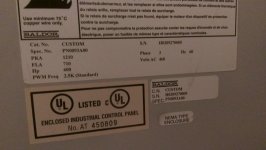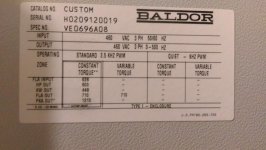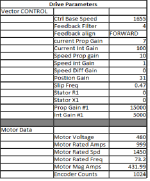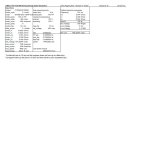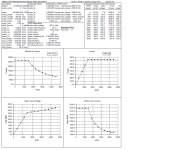g.mccormick
Lifetime Supporting Member
We have an older Baldor drive connected to a motor that is a dyno. We currently have this connected to a test article that is just being driven along as a pump.
Currently the drive is configured as torque mode, with bi-polar +/-10V for the torque command. My system is outputing +/-10V to control the drive/motor in for either speed or torque. When i get to a higher speeds (about 3700rpm) I am only there for a few seconds before the drive faults out.
The drive faults are:
The converter is faulting with : PWR BASE FLT
The inverter side is faulting with: LINE REGEN FLT
As mentioned, this test article is being motored only. Due to the high speeds, and inertia, we are seeing very high torque spikes on the torque flange. I'm not sure if these spikes along with my output changing very fast (to attempt to control speed) is what is causing the drive to fault? Is the drive attempting to supply current back and forth too fast?
The current setup has the drive torque mode jumpered (so it always is in torque mode) and forward and reverse also jumpered.
Questions:
1. If I remove the torque mode jumper and run in speed control mode, is the analog signal (0-10V) equal to 0-Max motor speed reference to the drive? I did not seem to find anywhere that specfied the reference anywhere.
2. Does the forward and reverse need to be enabled for any reason? I'm guessing not correct? I never want to rotate in the reverse direction, but will at times need to regen a lot while spinning in the forward direction.
Any help?
Currently the drive is configured as torque mode, with bi-polar +/-10V for the torque command. My system is outputing +/-10V to control the drive/motor in for either speed or torque. When i get to a higher speeds (about 3700rpm) I am only there for a few seconds before the drive faults out.
The drive faults are:
The converter is faulting with : PWR BASE FLT
The inverter side is faulting with: LINE REGEN FLT
As mentioned, this test article is being motored only. Due to the high speeds, and inertia, we are seeing very high torque spikes on the torque flange. I'm not sure if these spikes along with my output changing very fast (to attempt to control speed) is what is causing the drive to fault? Is the drive attempting to supply current back and forth too fast?
The current setup has the drive torque mode jumpered (so it always is in torque mode) and forward and reverse also jumpered.
Questions:
1. If I remove the torque mode jumper and run in speed control mode, is the analog signal (0-10V) equal to 0-Max motor speed reference to the drive? I did not seem to find anywhere that specfied the reference anywhere.
2. Does the forward and reverse need to be enabled for any reason? I'm guessing not correct? I never want to rotate in the reverse direction, but will at times need to regen a lot while spinning in the forward direction.
Any help?



